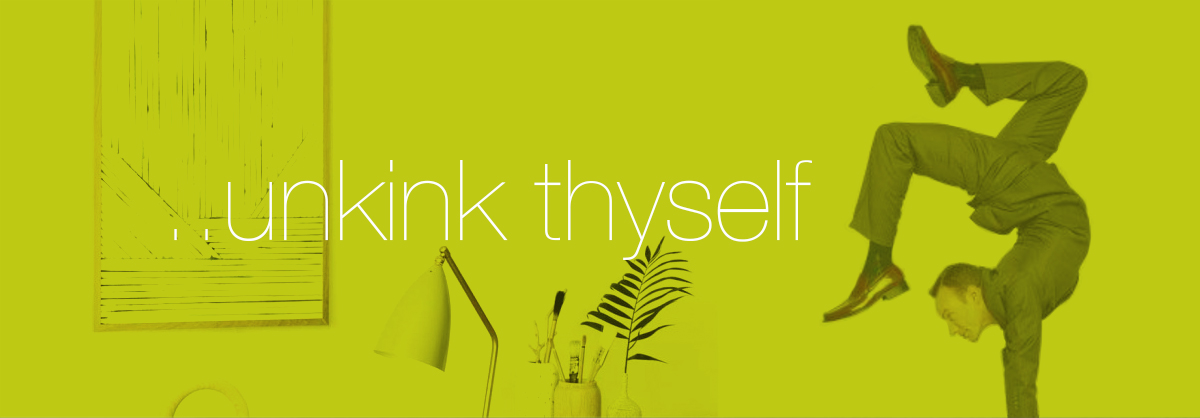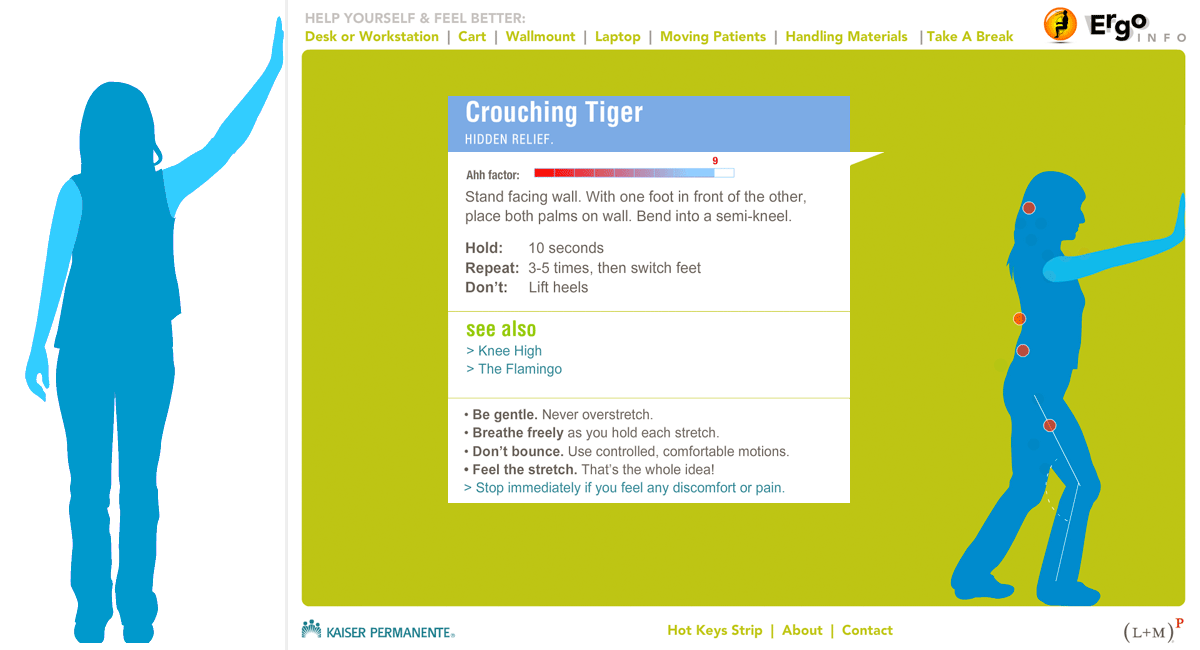Case Study: Ergonomics
The Injury Management Challenge.

Kaiser Permanente has always been in the forefront when it comes to using technology to solve some of the health challenges. Yet, ironically it was facing unusually high number of workers compensation claims due to workplace injuries – more than the industry standard. Besides obvious cost, Kaiser took this as a challenge to demonstrate its commitment towards helping their employees and as an industry leader in healthcare.
We (multimedia department) was brought in to solve this challenge with the help if technology.

![]()
– a person who does a scientific study of the customs of individual peoples and cultures.
As a lead designer, my primary role was to understand the workplace safety issues. Develop insights through interactions with the users and come up with solutions that not only reduced the claims but also helped Kaiser employees have a safe environment to work in. With the help of 2 junior designers, we create a webapp that helped exceed our goals in reducing the claims and operational losses.

Workers compensation claims is a challenge that every employer has to face. The cost of paying for claims in lot less compared to the operational cost to make up for the missing employee. Investigation of the claim. Cost of replacing, hiring, training new employee. Loss of productivity. Extra supervisory time. Legal matters. Higher insurance premiums. Down time. Lost opportunities and more.

Wellness of employees.
On the other side, the employees faced even more challenges. Lost of wages and opportunities. Long-term pain and health issues. Hard time finiding new work and more. This issue of workplace safety caused problem for both sides and clearly worth solving. Companies nationwide lose over half a trillion dollars due to workers compensation claims.


Before we started sketching ideas, it was important to learn about our users (Kaiser employees), their routine and activities related to kids transportation. We also needed to understand the current transportation options and environment surrounding it. We first made a list of things we needed to observe, listen and experience ourselves.
Learning
What were some of the workplace environment or settings causing the issues?
Which user type of employees had higher proportion of claims in the company?
What were the most common health issues reported in these claims?
Insights
Which type of employees had complaints/issues in regards to workplace safety?
Which type of employees currently had the least positive experiences with the workplace environments?
Opportunities
In what ways does Kaiser currently support positive experiences for its employees at the workplace and where it lacked support?
What are some of the ways other companies overcoming these issues?
Without defining the workplace safety solution, what positive experiences or benefits could the workplace safety majors help support for employees and Kaiser?

 As part of this observation, we spoke to over 60 employees and got a deeper understanding about the challenge.
As part of this observation, we spoke to over 60 employees and got a deeper understanding about the challenge.
• Majority of employees in office setting had complaints about their back and wrists, mainly dues to sitting all day long in front of the computer without regular breaks.
• Depending on user profile (management, nurses, doctors, front-desk..), over half of the employees had their desk cluttered – making it hard to find things and causing repetitive motions, adding to injury.
• Besides office environments, employees in other departments such as patient handling and equipment handling also had complaints with their lower back.
• 18% resources were consumed by human resources to fill in open/temp positions vacated due to workplace injury – much higher than industry standard for a similar healthcare company.
Some of the key findings from our survey.
• 66% requested better equipment / furniture to help themselves. 16% blamed changing work environments due to computers.
• 17% employees unaware of ergonomics and its benefits.

Kaiser is known for its preventive approach with healthcare and this was a classic problem that could be solved by being proactive. We proposed a training app that would help the employees learn about proper posture and its benefits. The app would also further enhance the experience by showing the users how they can modify their environment to suit their needs and create a safe place to work.

Who wants to watch another video about ergonomics?
Before designing the app, we discussed the solution with our prospective users and we got a push back about another ‘training’ program. Despite the pain being real, users were not convinced that a training video will be enough to solve their problem. We created MVP with simple flash animation and tested with small number of users. Once we got the positive feedback we sketched out a plan in implementing the first module to help the office staff.

We realized that even though bulk of complaints were coming from office staff using computer, other departments also needed help in handling patients and equipments properly to avoid long-term injuries.
Here were different type of users and how their interaction made an impact on the community.



Our initial MVP was shared with two Kaiser locations (approx. 300 office staff) in office environments. The feedback helped us iterate and fine tune the app before scaling the scope of the project. One of the negative feedback caught us by surprise. Even though Kaiser is healthcare company a lot of its employees had hard time understanding the medical terminologies in the app.
Result: In a 2-week trial where users spent 3 hours learning about proper posture and adjusting equipement. 74% were extremely satisfied with the change. 18% identified they needed proper furniture/hardware and 6% had technical challenges in accessing the app.

Early feedback gave us the direction and we prototyped the whole module. Our in-house photographer shot the various postures that were used to trace the images in Illustrator. These EPS files were then imported to flash and created frame-by-frame animations. With action script we stitched all the various modules together and launched the final app in all of Southern California Kaiser locations.


The scope the project extended beyond training module. We created mirror stickers, posters, banners and much more to remind employees to work and play safe.
Version 2.0:
The webapp was very well received by the employees and worker compensation claims reduced by 32% in 1 year! Over the time, we added six new modules (work environments) to help remaining employees. The doctors who were part of the office staff saw the benefits for themselves and started requesting similar tool for their patients. As a result, the training program was reconfigured and launched to serve Kaiser’s 11M members.


 We started the project to help the legal and HR Department to reduce workers compensation claims. We reduced the count significantly and were also able to help Kaiser employees develop healthy habits, reduce stress and workplace injuries. The program earned numerous accolades from the industry and became stepping stone to serve the larger community of Kaiser’s 11M members. The ROI on this project was 10 fold and we were able to help the community to have a health and happy lifestyle – both at work and home, through this webapp.
We started the project to help the legal and HR Department to reduce workers compensation claims. We reduced the count significantly and were also able to help Kaiser employees develop healthy habits, reduce stress and workplace injuries. The program earned numerous accolades from the industry and became stepping stone to serve the larger community of Kaiser’s 11M members. The ROI on this project was 10 fold and we were able to help the community to have a health and happy lifestyle – both at work and home, through this webapp.
Personally, I learned about workers comp and its impact on companies and individuals. It was a huge learning experience on how language makes a difference in communicating complex concepts. (had a new found respect for copy writers). As a designer, I spend lot more time in front of a computer than I should. Working on this project helped me develop a habit of taking regular breaks and have not had any complaints since.
Back to Ergonomics folio.


